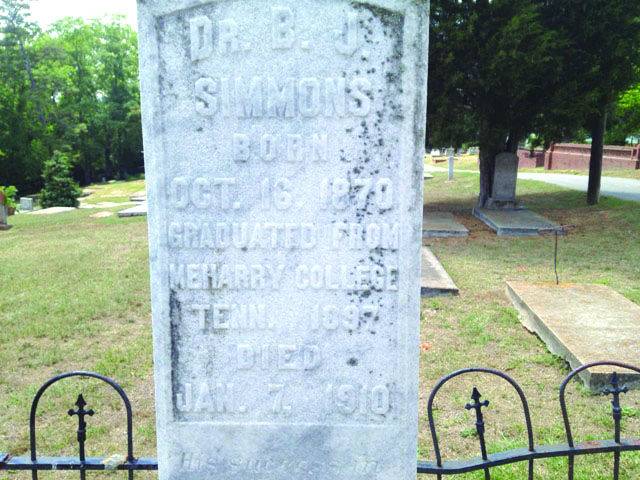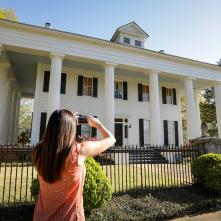Article originally appeared in the Union Recorder, by Vic Powell: http://www.unionrecorder.com/news/b-j-simmons-prominent-physician-etched-in-local-history/article_0de5c0dc-d1a7-11e5-a6ca-bf7125a26d94.html

Although the Emancipation Proclamation was signed Jan. 1, 1863, declaring all slaves in rebel states free, slavery did not officially come to an end in America until Dec. 6, 1865, with the ratification of the 13th Amendment to the U.S. Constitution. Black citizens of Georgia, Milledgeville and surrounding areas endured about a century more of second-class citizenship due to institutional oppression.
It was very difficult for many black people to get an education in Southern states, but Benjamin Judson Simmons, Milledgeville’s first black physician, was dedicated to the task.
Simmons was born Oct. 16, 1870, in Dublin. He dedicated himself to the task of education from an early age, and most of his early education was self-taught. According to the book “Remembering Milledgeville: Historic Tales from Georgia’s Antebellum Capital” by Hugh T. Harrington, Simmons attended public school in Laurens County until his family moved to Macon.
In Macon, he attended Ballard’s Normal School and later went to Georgia State Industrial School in Savannah.
Simmons was interested in becoming a physician, but his family was very poor. Harrington wrote that Simmons walked from Dublin to Nashville, Tenn., to attend school at Meharry Medical College.
The distance from Milledgeville to Nashville is about 346 miles on modern roads. The estimated walking time is 115 hours, or nearly five days, if a person does not rest and keeps a constant pace.
Sandra Jones, a local black history historian who leads the black history tour by the Milledgeville Convention & Visitor’s Bureau every year, agrees.
“He (Simmons) walked from Dublin, where he was born, to Tennessee,” Jones said. “He walked back and forth from Nashville to Milledgeville to attend Flagg Chapel.”
The date of his graduation from medical school varies. Jones said she has heard both 1892 and 1897 given as his graduation year.
“I think 1897 is closer to being correct,” Jones said. “There’s a lot of misinformation out there, so it’s hard to track down.”
What is certain is that Simmons set up his clinic in Milledgeville in 1897, thus becoming the city’s first black doctor.
Harrington wrote: “On one of his walks back and forth between Dublin and Nashville, Benjamin Simmons met his future wife, Clementine Slater, who was living in Milledgeville. After his graduation, they were married in Flagg Chapel church.”
However, Jones disagrees with Harrington on this count.
“He married the daughter of Alonzo Slater, Petronia,” Jones said. “My information comes from word of mouth, but I try to go back and research it. I think my information for Petronia comes from the relatives of Sallie Ellis Davis.”
Looking through newspapers from the time period, Jones is most likely correct about the name of Simmons’ wife. While neither Clementine nor Petronia Slater can be found in period newspapers, a Petronia Simmons is listed as the executor of Simmons’ will.
On page 4 of the April 30, 1912, edition of The Union-Recorder, a legal ad states: “To the heirs of B. J. Simmons, Leonard Reeves having applied for an order requiring Pretonia Simmons [sic], Executrix of B. J. Simmons, deceased, to execute titles to land in said application described, you are hereby notified to be and appear at the May term, 1912, of the Court of Ordinary, and enter your, objections, if any you have, why said order should not be granted, as said petition will then be heard.”
Several other legal ads saying much the same were also published, all of which list Petronia as the executrix of Simmons’ will.
In either case, both women were the daughters of famed Milledgeville builder and founder of Slater’s Funeral Home, Alonzo Slater.
While Simmons stayed out of politics and mostly served the black community, he became very wealthy and was highly regarded in Milledgeville. Many white physicians praised Simmons’ medical knowledge, and he was well known as a great diagnostician.
“He was very highly regarded by white physicians of his time because there was an attempt to push him out of business at one time,” Jones said. “He was asked to sign a fee schedule to continue to practice, and many black residents could not afford those fees at that time.”
A fee schedule is a listing of fees used to pay doctors.
Simmons is mentioned several times in old newspapers, but always in passing when the newspaper reported on an event involving injury to a black person. An Aug. 22, 1899, article in The Union-Recorder states that Simmons was called in to treat 19-year-old John Bishop who fell from a train and had his legs crushed. In that case, Simmons decided on amputation as the best chance to save the man’s life; however, the Bishop died of shock several hours after the surgery.
In the Oct. 15, 1901, edition of The Union-Recorder, it is published that Simmons treated several black residents who were injured in a fight involving a knife.
Unfortunately, Simmons’ died at the relatively young age of about 40.
“From what I was looking at, he died fairly young,” Jones said. “I’ve been told he died from a self-inflicted gunshot wound, but also that it wasn’t suicide. There are some Simmons family members in Milledgeville I’ve been trying to talk to.”
The book “Images of Milledgeville” by Amy E. Clark-Davis states: “The cause of his death was reported in ‘The Milledgeville News’ on January 14, 1910, as an illness that lingered for several months.” Harrington wrote in his book: “Sadly, he died as a result of a freak accident from an unintentionally self-inflicted gunshot wound. ... The death of B.J. Simmons deprived Milledgeville of one of the most eager, determined and promising physicians in the state.”
The Jan. 11, 1910, edition of The Union-Recorder states: ”Dr. B. J. Simmons, a colored physician in this city died at his home Friday morning about two o’clock. He had been ill several days. He came to this city from Dublin several years ago, and soon had a good practice among the members of his race. He accumulated a good deal of property. The funeral services of Dr. Simmons were held at Flagg’s Chapel Sunday afternoon, and were largely attended.”
Simmons is buried in Memory Hill Cemetery, West Side, Section J, Lot 1, Person 1. Several of his descendants still live in Milledgeville.
 Things To Do
Things To Do
 Events
Events
 Food & Drink
Food & Drink
 Hotels & Lodging
Hotels & Lodging
 Plan Your Trip
Plan Your Trip

